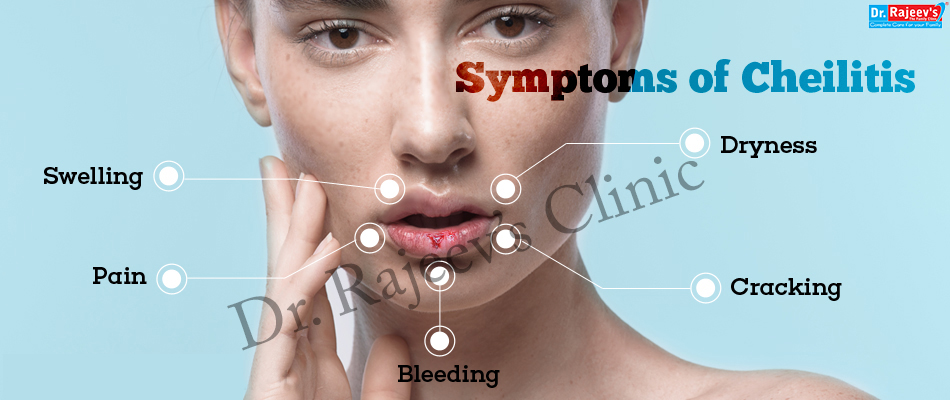

Cheilitis is a medical name for inflamed lips. It is also referred as chapped lips, where the lips that appear dry, scaly, inflames, and with cracks. The inflammation could be mild to severe. The condition is painful. If the cracks are deep, the lips could bleed.
Chapped lips may be seen in people of all ages.

The most common "lip" symptoms associated with cheilitis include:
There are different types of cheilitis, based on what causes them.
The most common type of cheilitis is eczematous cheilitis which may be associated with atopic disease (eczema, hay fever, and asthma) or occur as a result of an allergen or irritant exposure.
Atopic cheilitis is commonly seen in people with eczema but is often indistinguishable from allergic or irritant contact cheilitis but
Allergic or irritant contact cheilitis is caused by a reaction to an irritant or allergen that touches the lips, such as:
Angular cheilitis causes inflammation of the skin located at the sides or "angles" of the mouth. Basically, saliva collects at the angles of the mouth, eventually leading to dryness and cracking of the skin as the saliva dries up. Secondary infection with the fungus, Candida albicans ("yeast"), or less commonly the bacteria, Staphylococcus aureus ("Staph"), may then develop.
Certain people are more prone to developing angular cheilitis, such as those with diabetes or older individuals who wear dentures.4 People who take medications that cause dryness, like isotretinoin (formerly Accutane) for acne may develop this condition. Those with a vitamin B or iron deficiency are also more prone.
Actinic cheilitis is also called solar cheilitis because it is caused by long-term sun exposure. It is a pre-cancerous condition (squamous cell carcinoma of the lip) that most commonly occurs in light-skinned individuals, and in people who live in hot, dry climates and/or work outdoors, like construction workers.Actinic cheilitis is more common on the lower lip than the upper lip.
Other types (albeit rare) of cheilitis include:
Depending on the probable cause, the treatment is targeted. Homeopathy offers effective and safe treatment for Cheilitis during acute as well as chronic states. In case of vitamins deficiency, the supplements are obviously required.
The homeopathic approach is to enhance body’s own healing capacity so that the all deviations of the immune system are brought back to normal.
Cundurango – For Painful Cracks at Corners of the Mouth
Cundurango is a top-grade remedy for angular cheilitis prepared from the dried bark of the condor plant. This is a plant of the family Asclepiadaceae. It gives great results where painful cracks at the corners of the mouth are present. The cracks can be quite deep. In some cases, the corners of the mouth may be ulcerated.
Graphites – When Corners of Mouth are Dry, Rough, with Cuts
Graphites is a very effective medicine in cases where the corners of the mouth are extremely dry, rough and have deep cuts. These corners are highly cracked and fissured. Apart from this, it is an excellent medicine to treat cases with eruptions, crusting or ulcers at the mouth corners. They have a watery, sticky, gluey discharge. It also helps reduce scaliness in eruptions. In many cases, dryness, cracked lips, and a persistent burning sensation is also present with the above symptoms.
Petroleum – When Deep Cracks Bleed
Petroleum is considered in cases of angular stomatitis when there are deep cracks at the mouth corners that bleed often. Along with this the skin is rough, thick and hardened. The condition is worse in cold weather. Its use is also made when there appear crusts at the angles of mouth with redness, burning, itching and bleeding. Another indication to use it is eruptions at mouth corners with scaliness.
Natrum Mur – For Blisters at Mouth Angle
Natrum Mur is well indicated for treating angular cheilitis with blisters at the mouth angle. With this the corners of mouth and lips are dry, ulcerated, and sometimes cracked too. Sometimes there appears scabs on the lips with burning, smarting sensation and sometimes bleeding.